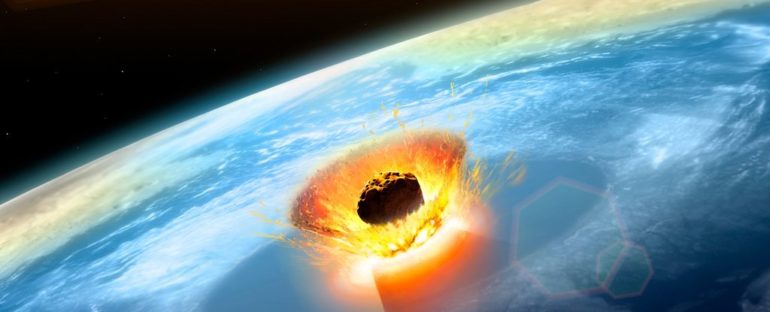Having dominated the planet’s surface for hundreds of millions of years, dinosaur diversity came to a dramatic conclusion some 66 million years ago at the hot end of an asteroid impact with what is today Mexico’s Yucatán Peninsula.
It’s a theory so swollen with data that it’s hard to imagine any room for doubt remains that this is indeed what happened. Were it a cold case, it’d be rubber-stamped and filed under ‘Solved’ by now.
But scientists are a nitpicky bunch, and a tiny gap in the chain of evidence linking signs of a global apocalypse with the scene of the crime has been begging to be closed.
An international team of researchers collaborating on a study of material from the Yucatán Peninsula’s famous Chicxulub impact crater has finally matched the chemical signature of meteoritic dust within its rock with that of the geological boundary representing the dinosaur extinction event.
It appears to be a clear sign that the thin blanket of dust deposited on Earth’s crust 66 million years ago originated from an impact event at this very spot.
“We are now at the level of coincidence that geologically doesn’t happen without causation,” says geoscientist Sean Gulick from the University of Texas in the US.
Together with fellow geoscientist Joanna Morgan from Imperial College London, Gulick led an expedition in 2016 to retrieve a sample of shattered rock from more than half a kilometre into the crater’s peak ring.
Four different laboratories carried out measurements on the sample. The results not only help unite a major transition in the fossil record with the site, they also hint at a timeline that supports a rapid drop in dinosaur populations over as little as a decade or two.
“If you’re actually going to put a clock on extinction 66 million years ago, you could easily make an argument that it all happened within a couple of decades, which is basically how long it takes for everything to starve to death,” says Gulick.
Half a century ago, the question of why the diversity of fossils representing the Mesozoic era came to such an abrupt end in the geological record was an open one. Whatever was responsible for the sudden loss of 75 percent of life on Earth, it had to be relatively quick, and global.
Hypotheses of such cataclysmic violence were mostly centred on two possibilities – one emerging from underground as a surge of volcanic activity, the other from above in the form of a comet or asteroid strike radically disrupting global climate.
In 1980, American physicist Luis Alvarez and his son, a geologist named Walter, published a study on a thin layer of sediment dividing the dinosaur-populated Cretaceous period from the post-dinosaur world of the Palaeogene.
A defining characteristic of this millimetre- to centimetre-thick thin strip of sedimentary rock was an unusually high amount of the element iridium, a metal that isn’t found in abundance in Earth’s crust.
One place you will find plenty of iridium is in meteorites. So Alvarez and son’s discovery marked the first solid piece of evidence that something from space splattered its remains all over the planet at the time dinosaur biodiversity took a dive.
Coincidentally, the site of that colossal collision was the focus of ongoing research around the same time, though making a clear connection between the 180- to 200-kilometre-long (112- to 125-mile) scar at the southern edge of the Gulf of Mexico with the killer asteroid wouldn’t happen until the 1990s.
Since then, evidence in support of an asteroid impact has only grown stronger, with models going so far as to suggest the angle, as well as the location of the Chicxulub impact, played crucial roles in the magnitude of the extinction event.
Signs that a zone of intense geological activity in western India called the Deccan Traps was contributing vast amounts of greenhouse gases at the time meant the volcano hypothesis has never been entirely ruled out, at least as a possible contributing factor.
Whether this tectonic hotspot played any role in the famous extinction event, or even helped biodiversity recover from it after, is still up for debate.
What is no longer a point of serious discussion is whether the 12-kilometre-wide chunk of rock that struck off the coast of what is now Mexico roughly 66 million years ago is the same one that dusted the remains of countless dinosaurs.
“The circle is now finally complete,” says study leader Steven Goderis, a geochemist from the Vrije Universiteit Brussel in Belgium.
Case closed.
This research was published in Science Advances.



